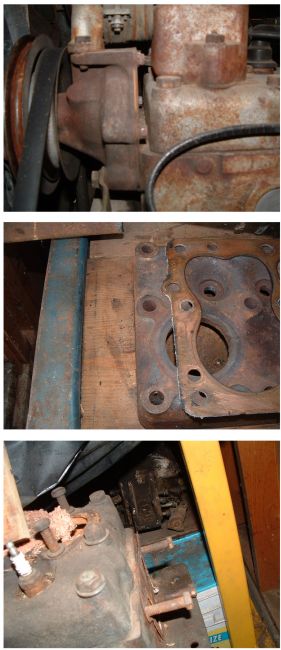
Posted by Clint Dixon [74.206.63.42] on Tuesday, November 20, 2012 at 17:19:49 :
In Reply to: I did it to test it out... posted by CSCameron [68.228.198.56] on Tuesday, November 20, 2012 at 15:12:45 :

I think Kaegi confirmed what I suspected. When they did away with the external bypass, internal bypass was created with a different waterpump, elbow, thermostat, head, and block. Thanks Kaegi. I forgot about the block.
Well, it took some contorting and a ripped pair of jeans, but I went out to my pile of parts and got some more photos.
The top image is from my ’47. You can see there is approximately a 3/8” gap between the waterpump and the head, and the front surface of the head is perfectly flat. The middle image is of a spare head. Also notice that the front surface of the head is flat and the head gasket lying on top of it has a bulge at the front edge and a hole through this bulge that does not match up with the bolt holes in the head. If you look closely, you can see how this gasket was used under this head and the bulge stuck out beyond the head. You may be able to make out a vertical line where the edge of the head “pinched” the gasket with the part that was sticking out remaining thicker than the rest.
The bottom image is of an industrial 230 that I have. The front surface of the head is not perfectly flat. It has a rectangular protrusion with fillets that blend it back into the head. Just below this protrusion you might be able to see the bulge of the gasket just sticking out. This engine did not have an external bypass. I believe what we are seeing here is the internal bypass that required a different block and head – among other items mentioned above. I could not get the camera back any further, but just above the waterpump bolt closest to the camera is a round hole in the waterpump gasket (about the same diameter as the bolt). I have seen this same hole in the back plate on a refurbished waterpump. I believe this is where the coolant bypasses the thermostat and passes into the waterpump.
Which head do you have, flat on the front surface or with the rectangular protrusion? If it is flat, you definitely need the external bypass elbow and the water pump that will accept the bolt on elbow. How you have plumbed the heater hose back to the block is currently providing a bypass, but be careful not to close the valve where the coolant exits from the back corner of the head. This would cut off all bypass – assuming you do not have the head with the bypass hump.
I don’t think temperatures are causing the abnormalities you are seeing in your engine reaching its operating temperature. There really is not that much difference between 60 degrees and 90 degrees. My experiences with thermostats have shown that they will cause an engine to reach and maintain its operating temperature regardless of outside air temperature, as long as everything is correct and working properly. There may be a slight difference if you are comparing 100 degrees to 30 below, but you should not see any difference between 60 and 90.
I had problems with a thermostat that would not close completely. I saw this as I was testing it in a pan of water on the stove. It was not open far, but the only time the engine would get to operating temperature was during a high-speed drive. I think the hole you drilled is causing too much coolant to flow to the radiator, cool too much, and not allow the engine to get up to temperature.
Junior
Follow Ups: